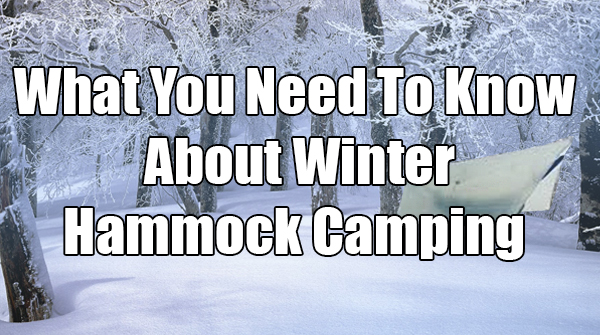
Choosing The Right Type Of Hammock
You don’t have to buy a different hammock for winter camping. You can use the same hammock you always use. You just need to make sure you are equipped with an underquilt, sleeping pad, low temperature sleeping bag and an over quilt. You don’t need all these items, but the more the better. But if you are hiking to a location and the weight load is a factor, just make sure you have at least 2 of the 4 items that was just mentioned. I’ll explain more.
Why A Underquilt For Winter Hammock Camping
An underquilt is basically the lifeline to winter hammock camping. I’ll explain why. If you are an experienced hammock camper, you already know this. So this is for the novice. You will lose your body heat and get cold even on fairly warm nights due to a process called convection. This is due to the fact that air is moving above you and below you and taking away all the heat from your body as it gets wicked out thru the areas of the hammock that are fully compressed by the weight of your body. A good underquilt will help create an insulated dead air space under you and help prevent heat loss. Match this with a good sleeping pad and you are nice and warm even in real frigid temperatures. Now, what about losing heat from above?
Top Quilt Or Sleeping Bag
There are many winter hammock campers that have spent many many nights without ever using a top quilt. So is it a necessity? No, not really. But you do need something to cover up with. A good wool blanket or a sub zero sleeping bag are both viable alternatives. Remember once in the hammock, movement is limited. A top quilt is basically a foot box and a blanket. so it is easy to get your feet inside and covered up. So why not a top quilt with a good wool blanket or an unzipped sleeping bag over the top. These are great for those extremely below zero cases.
Do You Need A Roof For Your Hammock
No, you can camp without one. But a good hammock tarp will keep the rain off you in the warmer months and snow and cold winds in the winter. But there are benefits of packing a larger tarp for winter months and pitching it over your hammock. It works great as a wind break if you are in an open space. For example, you found two perfect trees set up perfect for you to hang your hammock. But there are many wide open spaces where the wind can whip right through creating a bone chilling wind chill that is uncomfortable when you are not tucked away deep inside your hammock sleeping.
Pitching That Tarp
Winter Dangers You May Not Have Thought Of
Winter weather will present different dangers that you may not have thought of. Freezing cold weather can cause trees and tree branches to be extremely brittle. This make them very vulnerable to breaking during heavy snowstorms, ice storms or just high winds. So keep this in mind when choosing a place to hang your hammock.
Also cold weather can create cold sinks, low laying areas can be more colder then other places, so try and pick a spot in a higher elevation.
Added Ideas For Better Winter Hammock Camping
As stated above, low lying areas will be the coldest area due to the cold air settling. So pick an elevation that is not the lowest point in your area.
Pack a shovel. Use a shovel to dig through the snow down to the ground around the area you hang your hammock. Pile the snow up on the wind side to make a natural windbreak.
Pack a second tarp to use as a floor area around your hammock. this will benefit you as you can be barefoot or stocking footed before climbing into your hammock. This works extremely well when paired with a large tarp used as a walled roof.